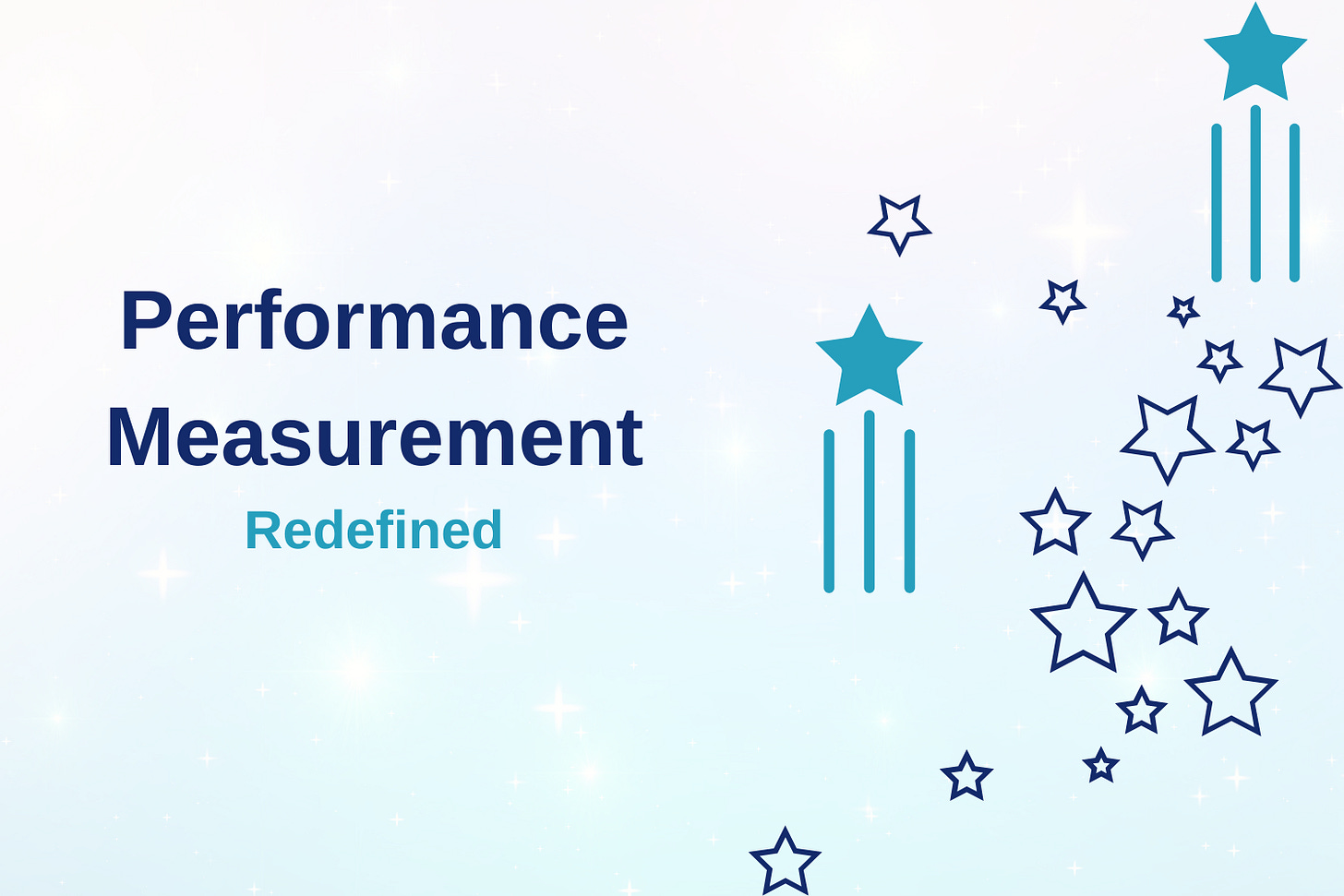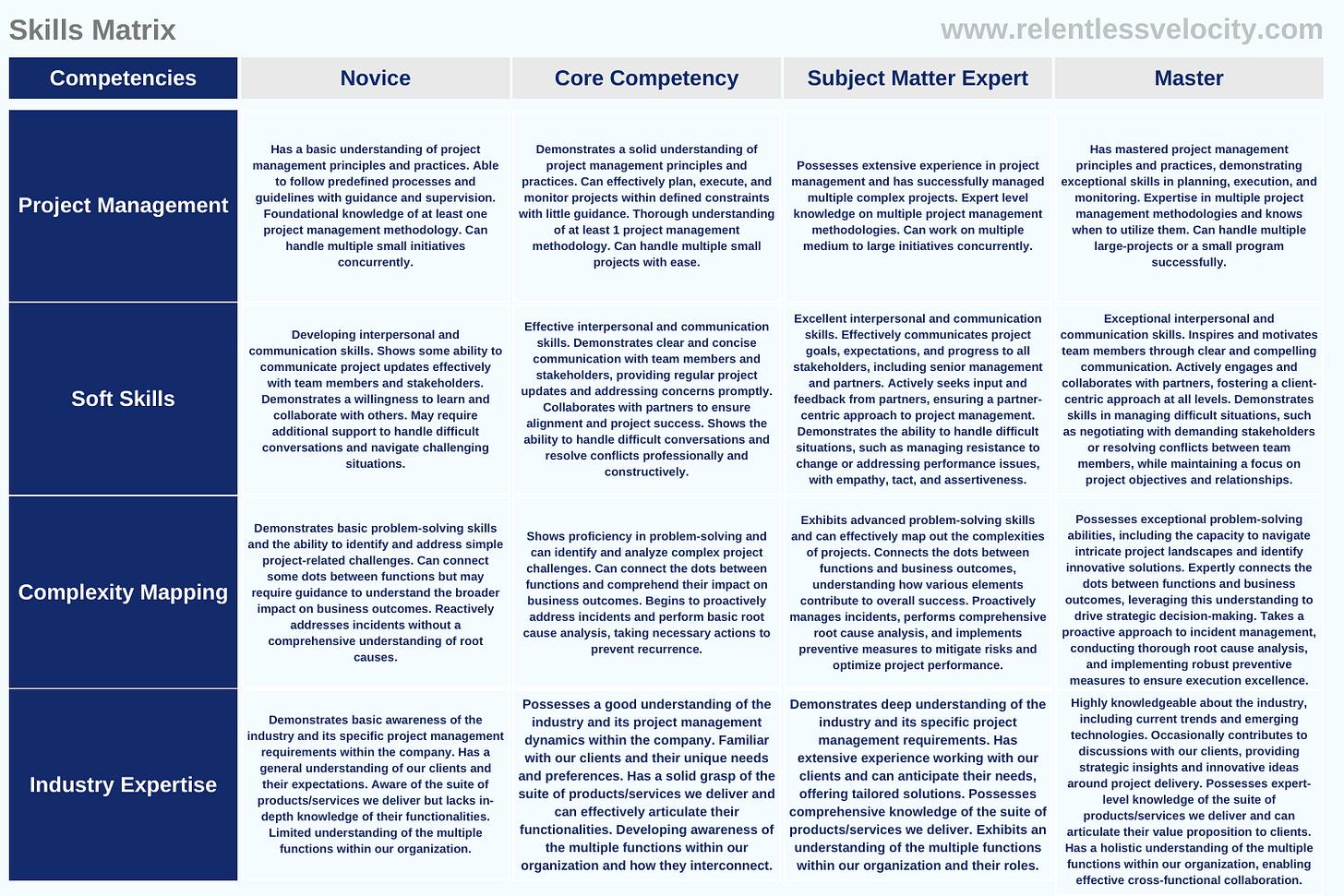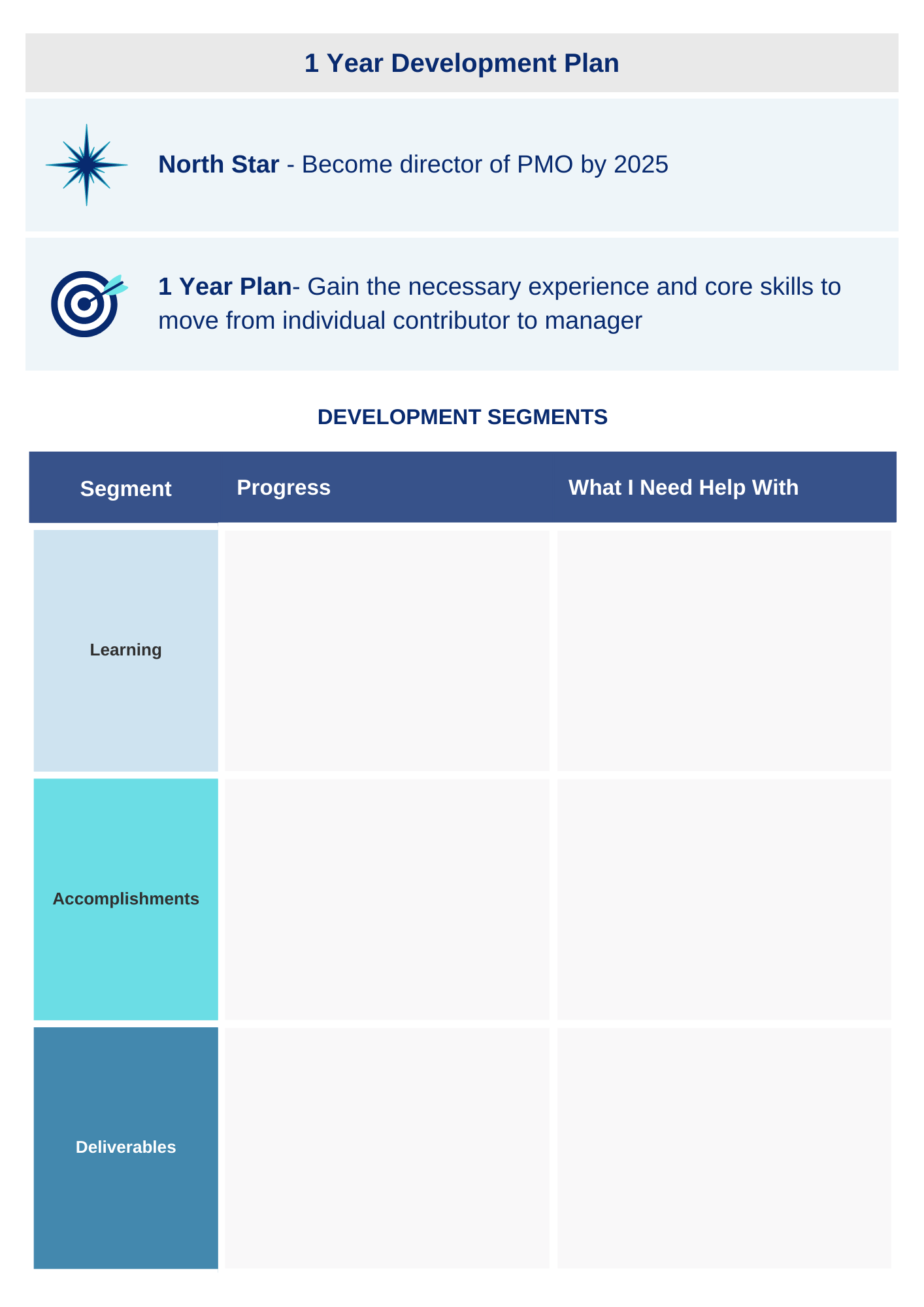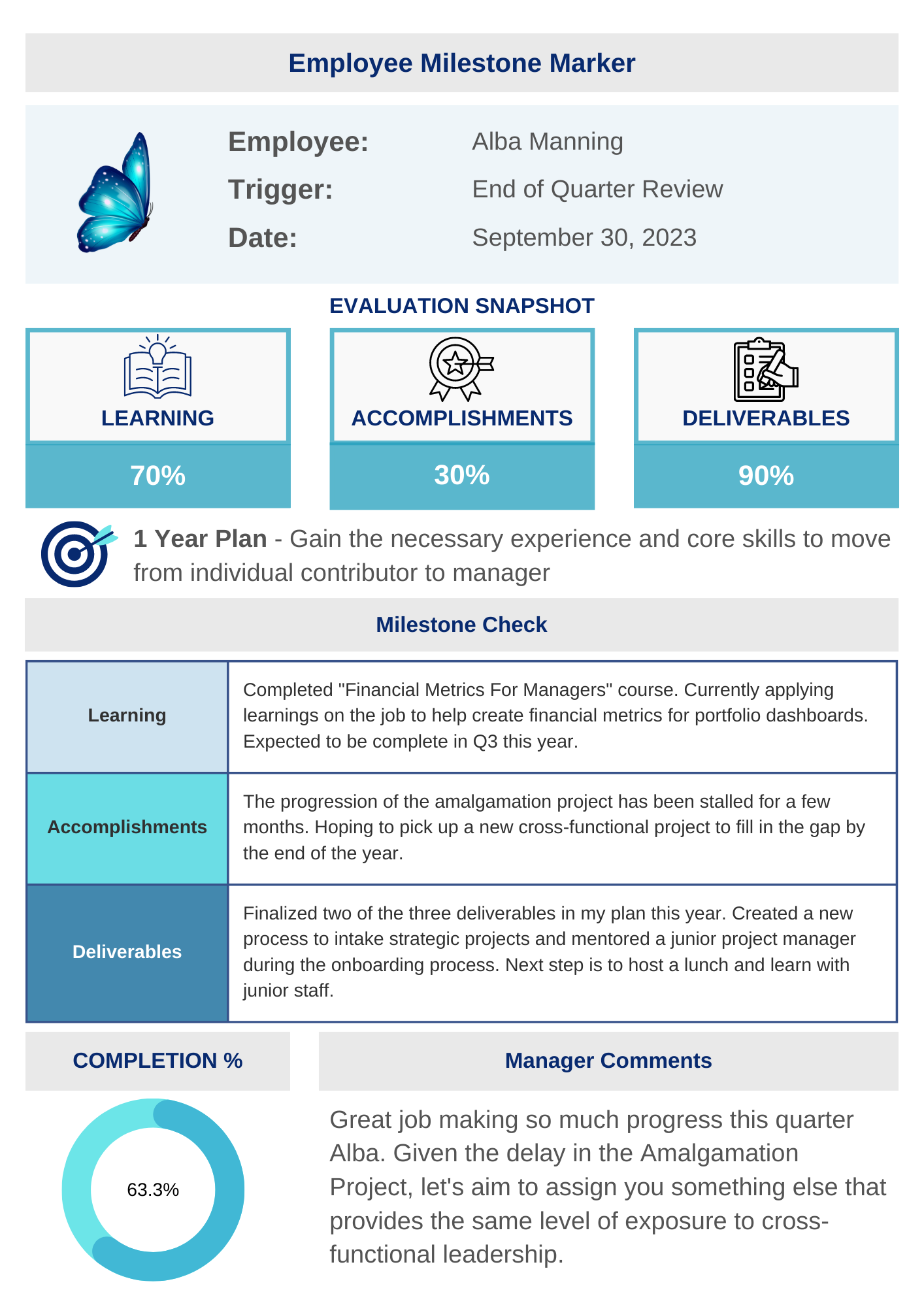Performance Measurement Redefined: From Evaluation to Empowerment
(#013)
Dear Subscribers,
Today I want to focus on the people side of management. Specifically, how we nurture and grow the talent on our teams.
I’ll be uncovering what works for me as a people leader and share some of the tools I’ve come up with along the way. I hope you enjoy reading it just as much as I did writing it.
And if you’re new here and enjoy what you’re reading, consider subscribing to be notified of new deep-dives when they’re released.
The transition from being an individual contributor to a manager is an exciting journey that comes with a steep learning curve. Along with the new title comes a multitude of challenges, including a broader range of responsibilities and increased decision-making authority.
A move into management also brings with it an additional layer of responsibility that’s (usually) pretty foreign to those just getting into the game - people management. Managing others can take various forms, ranging from overseeing a single direct report to leading a team of many individuals. As you progress as a leader, the complexity can intensify with multiple layers of hierarchy separating you from those who carry out the day-to-day operations of the business. Not easy to say the least!
Just because it’s hard, doesn’t mean you should shy away from it. In fact, it’s just the opposite. From my point of view, leading and nurturing one's employees should be the highest priority for today's managers, above everything else.
It's also the most under-utilized area of focus for managers, resulting in a significant opportunity cost that’s likely impacting their organizations more than they realize.
To start, managers who focus on their employees' personal development can do wonders for retaining staff. A noteworthy 2019 study by LinkedIn highlighted this fact. The study found that a remarkable 94% of employees would be inclined to stick with an employer if that employer prioritized their personal growth. This approach is cost effective as well. Based on my own observations, the costs associated with replacing employees tend to exceed the investment required for developing current employees.
Just as important, if not more so, is the strategic advantage companies gain by building and maintaining a healthy pipeline of leaders ready to fill opportunity gaps as the company grows. Building future leaders is now more important than ever. Companies need to pivot many times throughout their existence, and this will only accelerate going forward. As a result, there is no telling what areas of focus will emerge, what new departments will need to be established, or what skills will be required in the world of tomorrow. Having future leaders who are trained and already aligned with the company culture is like a cheat code – an inexpensive one, to be exact – that most companies would kill to have.
If you're a people manager yourself or have your sights set on becoming one, you're stepping into some pretty big shoes. Many managers these days simply aren't equipped to handle the heavy workload thrust upon them AND fulfill the vital responsibility of nurturing and cultivating their teams.
So where do you even begin? After spending some time on this topic, I can say with confidence the biggest gap at the moment is the way we measure employee performance. The approaches we take and the tools we use are incomplete and are in need of a massive overhaul.
Before jumping to solutioning, let’s first look at the pain points. Why is our approach to performance measurement of our employees so ineffective? I feel it comes down to three things.
It’s systematic, not iterative: Measuring employee performance, much like most things today, needs to be agile. Work output, including interactions, projects, and followed processes, happens every day. Amidst this, employees are in a constant state of learning, even if they don't realize it. They make mistakes, stumble, and then improve. Waiting until the end of the year to highlight a key learning that occurred 6 months ago leaves so much on the table for employee and employer.
It’s mainly company focused: Companies today, put too much emphasis on hard to measure aspects of performance, such as company values and buzz words. While culture fit is extremely important, gauging an employee's performance through this lens should cap at around 50%. Going beyond this limit not only dampens morale but also smothers creativity by overlooking where employees' genuine passions reside.
It’s not comprehensive: When assessing our employees' performance, we often do so solely through the perspective of our experience as people leaders. We owe it to our teams to appraise performance from a broader array of viewpoints than what we, as individuals, can provide alone.
People managers who can overcome these hurdles and, instead, learn the ability to measure their teams' performance in a way that breeds hyper productivity, engagement, and happiness among the group will be in high demand – and rightfully so. Having said that, I’m going to share some tools I’ve been experimenting with. These tools have shown significant promise for the businesses I oversee and the global PMO I lead. These are tools that effectively gauge employees' performance today and gradually lay the foundation for their growth into future leaders.
But before we dive into that, we need to start by adjusting the mindset of the people manager. Something I wish I had known when I took on my first role as leader of a team. It’s a simple question to start with: How should one approach being a people manager in the first place?
🌎 Part 1: The People Managers Worldview
Throughout my career, I've worked with people managers who were both my peers and who reported directly to me. While many of them have evolved into highly successful leaders in their own right, they all seemed to encounter a common challenge right from the start.
Do you have a guess as to what this challenge is?
To provide you with a comprehensive perspective, let me illustrate this with a fictional example. Allow me to introduce you to Justin, a senior performance marketer at a rapidly growing tech company. Over his two years with the organization, Justin has undeniably made his mark. He's nurtured crucial relationships across all business domains, achieved a staggering 350% surge in website traffic by introducing novel marketing channels, and significantly enhanced the efficiency of paid search and existing social media campaigns. Moreover, Justin wholeheartedly embraces the company's culture and embodies its core values.
Justin's supervisor and a handful of others have been closely monitoring his progress, and they're truly impressed by his work ethic, collaborative spirit, and notable achievements. Their admiration has reached a point where they believe a promotion is well-deserved, accompanied by a team of direct reports who can learn from his expertise.
Once the decision is finalized and Justin is informed, his elation knows no bounds. This marks a significant milestone in his career, one he views with immense pride. He eagerly anticipates the expanded influence and authority that comes with his new role, as well as the support of a team to propel his initiatives further. His ultimate goal, is to drive the company to even greater success through his leadership. In his eyes, his new team represents not only his accomplishment, but also an extension of himself to get more work done. The burden of an ever-increasing workload will no longer stretch him thin, preventing him from focusing on essential tasks.
However, after a few months of assuming the role of a people manager, Justin finds himself perplexed. Strangely, his team isn't as engaged as he is. Disagreements among his team members have arisen, and Justin can't help but feel a hint of irritation. Doesn't his team realize who the manager is? As these challenges persist for a few more months, Justin's supervisor steps in, needing to intervene—a development that casts a shadow on Justin's initial foray into people leadership.
Looks like things didn’t go according to plan for Justin.
If you didn't quite catch the situation Justin found himself in, he committed the same error that many new people managers stumble upon right from the start.
Newly appointed people managers frequently associate the presence of a team with a clear indication of their personal success, achievements, and authority.
Adopting this mindset sets you off on the wrong foot immediately. It instinctively narrows the attention away from the genuine asset: the people under your guidance.
For the best people managers, it’s the employees that really matter and dictate their success. Their primary objective, the one that truly ignites their excitement, is the opportunity to play a part in the collective and individual growth of their teams. The influence they wield, the extra responsibilities they take on, and any other perks that comes with being a manager are simply byproducts of this core purpose.
I urge all current people managers reading this to take a moment to assess their current perspective. Ask yourselves whether your teams are the driving force behind what you do and if their accomplishments and growth are connected to your own journey. If your answer is no, it might be worth dedicating some effort to realigning these aspects. This realignment becomes crucial if you have aspirations of pursuing leadership roles in the long term.
So you have a team and your worldview is aligned with the best people managers in the world today. This is great. Now we must do something about the way we measure performance, for the benefit of our teams and to create productivity that can take our companies to the highest peaks. Let’s explore that next.
📊 Part 2: Measuring Employee Performance The Right Way
In my perspective, the most effective approach to tackle employee performance measurement and development is to view it in layers—precisely four layers, as I've outlined below:
Creating the benchmark
Crafting the employee roadmap
Establishing the evaluation feedback loop
Implementing the milestone marker
For this process to truly succeed, it should kick off from the top, while maintaining a consistent overlap to reap the full benefits. Now, I'm going to look into each layer and lay out the reasoning behind incorporating them.
Creating the Benchmark
In order to effectively assess the individuals on your team, it's essential to initially grasp what greatness looks like across multiple levels. I recommend kickstarting the process by asking yourself a series of reflective questions and taking the time to formulate detailed responses.
What's required for complete alignment with the company's values and mission?
What core competencies are necessary to truly thrive in the roles on my team?
What traits, experiences, and skills will become essential if we intend to scale the department or team beyond its current state?
These questions might be a bit challenging, but they're worth considering! To break it down further, the first question focuses on connecting with the company's values, the second looks at how well the employee fits their role, and the third looks ahead, to predict what's needed for expansion.
With the insights from these questions, you can start creating your first employee performance measurement tool – the skills matrix. Also known as a progression framework, I'm a big fan of this tool because it helps with two main challenges that often trip up new managers:
It offers a comprehensive overview of the potential career pathway for employees within your department.
It lays out a clear set of skills and outlines expectations for each role within your team.
That second point is really important as it serves as the foundation to level set expectations across your team. Just as beneficial, it can also be used as your measuring stick through the employee development journey.
I've created a few skills matrices in the past, and we've just initiated a fresh one for the PMO I'm leading. While the specifics of these tools may vary slightly across companies, industries and roles, it is my opinion that they should at least contain the following.
Roles: Particularly in larger departments, it's optimal to develop distinct skills matrices for each role. To illustrate, let's say your department comprises project coordinator, project manager, and program manager roles. In this case, each of these roles should possess its own skills matrix, with the coordinator role serving as a stepping stone to the project manager role, and so on.
Core Competencies: These are the overarching themes utilized to assess a specific employee's suitability for a role. They encompass skills such as problem-solving, industry knowledge, and communication.
Levels: A tiered approach that highlights the amount of competence/experience each employee has for the core competencies of that role. Some examples are 1. Novice, and 4. Master
With the identified structure in place, your job is to fill in the pieces by tying each core competency with its associated level for every role. When you’re complete, it should look something like this.
Keep in mind that the skills matrix acts as your team's compass, allowing them to gauge their present status and find direction for their career journey. It's a tool of immense value for them, just as it will be for you.
Crafting the Employee Roadmap
Every member on your team is a unique human with their own hopes, desires, and expectations. This holds true for their careers, just as it does for every other aspect of their lives.
As a people manager, it should be a priority for you to meet with them and understand what gives them motivation and in return, outline your own expectations for them.
Some questions to as ask are:
What fuels their drive to deliver exceptional work?
Where do they envision themselves over the next 3 years?
What are their aspirations for the upcoming 12 months?
Start a conversation with each of your employees and begin capturing these details. This is the perfect time to leverage the skills matrix to not only align their growth aspirations to the expected progression of the role (and the skill needed) you mapped out, it also allows you to identify exactly where opportunities for improvement lie. With that, you can begin the process of documenting a 1 year development plan, a.k.a. employee roadmap. I'd recommend structuring and documenting this plan using a variation of the template provided below.
North Star: Where does the employee envision themselves over the next 3 years, finding personal fulfillment while also benefiting the company?
1 Year Objective: What is it that the employee should accomplish in the coming year to bring them closer to their North Star?
Segment 1 - Learning: Which courses, educational programs, and reading materials will the employee commit to in order to meet their one-year goal?
Segment 2 - Accomplishments: What milestones does the employee intend to reach in the next 12 months to make progress towards their goal?
Segment 3 - Deliverables: What specific contributions or projects does the employee pledge to undertake in the next year, driving them towards their desired outcome?
Feedback: What areas are the employee struggling with and may need guidance?
It’s worth noting that this should be a highly collaborative part of the process. The employee needs to take ownership off their own development and the manager has to support growth through learning opportunities, coaching and good old time and effort.
Establishing the Evaluation Feedback Loop
High performing employees welcome feedback. It’s unfair to wait until the end of the year to have meaningful conversations with them on this topic. Instead, a much more impactful way to accelerate the growth of our people is by establishing a feedback loop with our employees.
Rather than waiting for annual performance review season, I incorporate regular, micro-sized evaluations in every 1 on 1 meeting I have with my direct reports. I carve out a specific time during these meetings to relay anything I’ve heard about them through others, positive or negative, including anything I’ve seen through my own observations. With this, I offer suggestions that hopefully generate new learning opportunities. Throughout it all, I’m also continually observing and assessing their progress based on discussions that happened in the past.
In order to make these micro-evaluations effective, you have to measure your employees with a much wider net. The way I do this is through the 360 review. For those of you who are not familiar with this exercise, the 360 review is the act of reaching out to the peers and colleagues of your employees, and capturing valuable feedback by asking them a series of questions. Ideally, these colleagues would have had direct interaction with your employee recently.
For this exercise, I find email works best as it offers the chance for those providing feedback the ability to think through their responses. Just as important, it’s much easier to send feedback surrounding a colleague this way. Holding a 360 in a more interactive format may be too much for some.
I tend to only focus on 4 questions to ensure I get lots of replies and keep things on point. Those questions are:
Based on your interactions with “employee x”, what would you say their strengths are?
What are some of the ways “employee x” can improve?
If you can describe “employee x” in three words, which ones would you use?
Is there anything else I should know?
After collecting feedback, I compile them in a document and during our next micro-evaluation, have frank conversations around what I learned in the field. To be clear, I don’t constantly hold 360 reviews, as that would be too time consuming. Instead, I try to do them based on milestones reached or to help balance my own findings for the employee in question. Overall, I tend to do them much more frequently than most companies require.
Implementing the Milestone Marker
Now we’re left with the final layer, the milestone marker. I refer to this layer as a modified version of the year end performance review. A great deal of the content is the same, the only real differences are:
The frequency: Instead of check-ins happening at the end of the year, which measure performance as a whole, it’s focused on specific milestones mapped out at the beginning during the creation of the employee roadmap. The milestone marker can be triggered by completed projects or even the end of the quarter.
The Outlook: Annual reviews, in my opinion, are 75% reactive and 25% proactive. The milestone marker flips that in reverse. Reviewing small snippets of outcomes more frequently with the ability to steer the ship in new directions if the need arises.
The milestone marker consists of two parts, the document to capture progress and the meetings themselves.
When it comes to collecting data, I like using interactive PDFs. These are shared with my team to fill out over the year, similar to the example below. This is just my personal choice; any spreadsheet or document software works too. When combined with the skills matrix and employee roadmap, team members can easily track their progress toward their goals without stressing about getting off track. This document stays dynamic and serves as a central reference during milestone marker meetings with employees.
The meetings themselves should be similar to your typical year end performance review. The only differences are these are proactive and don’t need to be too formal. it’s simply a matter of focusing on leading indicators of employee performance and growth versus lagging indicators.
Is there also room for the annual review? I believe so. The beauty of the milestone marker layer is it allows you to incrementally accumulate data throughout the year, making the annual review much easier for the manager to put together and more valuable for the employee as it will be accurate and there will be involvement every step of the way.
Conclusion
When you put everything together, it’s easy to see that the way we traditionally manage the performance and growth of our employees is severely lacking. It is now up to all of us, as people managers to push the idea of a more comprehensive and agile approach going forward.







Great article Guliano! Would you recommend People managers set up skills matrices and job levelling frameworks (common ones companies use below) in the absence of the company having one that's used by every team? Or should you push a company to set one up rather than creating a one that is tailored to your team?
https://ravio.com/blog/how-to-create-a-best-practice-job-levelling-framework